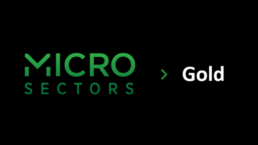Pure “Big Tech” Exposure With 300% Leverage
The evolution of technology benchmarks
Although the FAANG group of stocks – Facebook, Apple, Amazon, Netflix and Google (now Alphabet) – have a proven track record of innovation and growth, it can be challenging to obtain exposure to these companies in a single trade.
Historically, and prior to sector indices becoming as widely used as they are today, investors looked to broad indices like the Nasdaq-100 Index for a diversified exposure that included some technology holdings. Yet the Nasdaq-100 Index also held companies like Pepsi, Comcast, Starbucks and Costco, which made it potentially unsuitable for investors seeking exposure to a pure “big tech” index. Eventually, and with the help of the Global Industry Classification Standard (GICS®) to identify technology stocks, the industry moved toward more targeted benchmarks, such as the Technology Select Sector Index.
The trouble is that GICS fundamentally changed the way public companies were categorized. When S&P and MSCI updated their classification rules in September 2018, it meant that most internet-related companies were no longer eligible for inclusion in technology focused indices. They would instead be pooled with media and entertainment holdings under the newly designated sector, “Communication Services.” As a result, Visa and MasterCard (which are typically associated with financial services) are currently two of the top five holdings of the Technology Select Sector Index, while four of the five members of FAANG are not included in that index at all.
By contrast, the new Solactive FANG Innovation Index (related ETNs: BULZ, BERZ) offers equally-weighted exposure to 15 of the largest and most highly liquid technology stocks. Looking back at historical returns dating to 2014(1), the Solactive FANG Innovation Index would have outperformed broad market indices, such as the S&P 500® Index and Nasdaq-100 Index.(2)

Source: Bloomberg, 12/19/2014 – 9/30/2021. See footnote (1) above.
Investors will find eight core components in the Index, picked for their track record of innovation in rapidly growing industries, such as e-commerce, semiconductors, cloud computing and online streaming. There are also seven top-traded additions that are chosen based on market capitalization and trading volumes, meaning that investor demand will influence which holdings constitute nearly half of the portfolio.
Put another away, the index represents a more precise exposure for investors who want pure access to big tech stocks, concentrated in a small number of stocks.
More targeted, greater leverage
What sets the Solactive FANG Innovation Index apart are its related exchange traded products: the daily-resetting 3x leveraged BULZ and 3x inverse leveraged BERZ.
These exchange-traded notes (ETNs) operate under different guidelines than exchange-traded funds (ETFs), which typically need to own a minimum of 20 stocks in order to satisfy certain U.S. 1940 Act and federal tax requirements. The ETN structure can offer investors exposure to as few as 10 stocks; in fact, the ability to link to an index with fewer than 20 names is one of the core advantages of using ETNs versus ETFs.
Due to investors’ growing interest in “Big Tech” companies, and a potentially unmet demand for leveraged solutions, there was a conscious decision to avoid any holdings that could possibly distort the index’s highly focused view of innovation and growth. For example, non-U.S. entities, such as ADRs referencing Chinese tech companies, were omitted despite their size and importance, because these companies have been subject to increasing risks related to U.S. and Chinese government regulation. As another example, a “mega-cap” US software company was included as a core component of the index as opposed to a smaller social media platform company, given that the former has approximately 40 times the market capitalization and a much more substantial track record of growth.
Each of the eight “core” holdings in the portfolio are recognizable, large-cap technology companies domiciled in the United States, with the remaining seven “non-core” components coming from the top traded U.S. technology stocks. These non-core holdings are meant to reflect the potential evolution of investor demand in the market; they are reconstituted quarterly according to trading volumes and may change from time to time. The common thread through the selection process is that the index is designed to include companies building tomorrow’s technology today.
Solactive FANG Innovation Index Constituents:

(Index components as of the last rebalance date September 20, 2021)
Conclusion
Ultimately, every technology investor must decide how they want access to their desired amount of technology stock exposure. Ask yourself: will a basket of 70 to 100 securities allow you to express a precise view of the tech sector? Do you want a technology investment that omits Facebook, Amazon, Netflix and Google?
You can dedicate the time and resources needed to buy each stock directly, but that process can be inefficient for active traders who hold securities for days, if not hours. You can choose more traditional benchmarks, such as the Nasdaq-100 Index and the Technology Select Sector Index. Or you can opt for a solution that gives you exposure to some of the world’s biggest technology stocks – with 300% daily-resetting leverage and a focus on leaders in the technology sector.
Learn more about the Solactive FANG Innovation Index and get ongoing access to our expert industry insights by signing up for our newsletter.
Sources:
(1) Historical returns data taken from Bloomberg. The Solactive FANG Innovation Index was launched on June 8, 2021. Index data prior to that date is hypothetical and reflects the application of the index methodology in hindsight. The hypothetical data cannot completely account for the impact of financial risk in actual trading.
(2) Past performance is not indicative of future results.
The exchange traded notes are subject to the credit risk of Bank of Montreal, the issuer of the ETNs. The ETNs are also subject to the issuer’s credit ratings, and the issuer’s credit spreads may adversely affect their market value.
Leveraged ETNs are intended to be daily trading tools for sophisticated investors to manage daily trading risks as part of an overall diversified portfolio. They are designed to achieve their stated investment objectives on a daily basis. The returns on the ETNs over longer periods of time can, and most likely will, differ significantly from the return on a direct long or short investment in the index. Investors should carefully review the applicable offering documents for an ETN prior to making an investment decision.
Bank of Montreal, which participated in the preparation of this article, and is the issuer of ETNs described on REX’s website, has filed a registration statement (including a pricing supplement, a product supplement, a prospectus supplement and a prospectus) with the Securities and Exchange Commission (the “SEC”) about each of the offerings to which this free writing prospectus relates. Please read those documents and the other documents relating to these offerings that Bank of Montreal has filed with the SEC for more complete information about Bank of Montreal and these offerings. These documents may be obtained without cost by visiting EDGAR on the SEC website at www.sec.gov. Alternatively, Bank of Montreal, any agent or any dealer participating in these offerings will arrange to send the applicable pricing supplement, product supplement, prospectus supplement and prospectus if you so request by calling toll-free at 1-877-369-5412.



